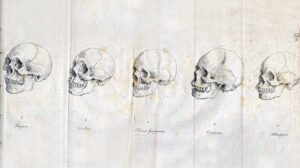
Credit: Special Collections and Rare Books, University of Minnesota Libraries
Expanding on the work of Carolus Linnaeus, German professor of medicine Johann Friedrich Blumenbach introduced one of the race-based classifications in On the Natural Variety of Mankind. In the second edition Blumenbach changed his original geographically based four-race arrangement to a five-group one that emphasized physical morphology (the study of the form of an organism). Blumenbach’s five categories were: Caucasian, the white race; Mongolian, the yellow race; Malayan, the brown race; Ethiopian, the black race; and American, the red race. Although he retained geographical names for his categories, the change marked a shift from geography to physical appearance.
The age of Enlightenment provided the backdrop for eighteenth century European theories about human difference. Exploration of Africa, Asia and the Americas brought Europeans in contact with people whom they found quite different. The rise of prominent Enlightenment thinkers including Voltaire, Jean-Jacques Rousseau, Immanuel Kant and David Hume, among others-greatly influenced European ideas about economics, government and science. The framework of Enlightenment philosophy in Europe was the belief that reason and rationality provided an authoritative system of ethics, aesthetic values and knowledge.
- One of the first efforts by Europeans to document human variation began wit French physician Francois Bernier’s Nouvelle division de la terre par les different especes ou races qui l’habitent, published in 1684. Loosely translate it was entitled, A New Division of the Earth, According to the Different Species Races of Men Who Inhabit It. Although there is a measure of uncertainty in the title about the appropriateness of the term “race” versus “species” to classify human variation, Bernier relied on categories based on outward physical characteristics such as skin color.
- A prime example of the Enlightenment’s influence in science is Swedish botanist Carolus Linnaeus’ system of biological classifications in Systemae Naturae, published in 1735. Linnaean taxonomy is the system of scientific classification of plants and animals now widely used in the biological science He formalized the distinction among the continental populations of the world and his work helped characterize the concept of race. In the tenth edition of Systemae Naturae, which was published in 1758, Linnaeus proposed four subcategories of Homo sapiens: Americans; Asiaticus; Africanus; and Europeanus.
- For the most part, Europeans acquired their information about Africans and Indians in North America, not from direct experience with these populations, but rather primarily from those involved in the slave trade, missionaries or Americans like Thomas Jefferson, who wrote about Africans and slavery. If anything, Europeans were ethnocentric and naïve in their descriptions. This is especially true in Linnaeus’ classifications of “Homo ferus” (wild men) and “Homo monstrosus” (monsters). The early Enlightenment thinkers like French naturalist George Louis de Buffon, posed naturalistic explanations for human variability, influenced most European intellectuals.
- During the eighteenth century, most of the well-known taxonomists and naturalists in Europe were trying to classify biological variation around humans in terms that were familiar at the time. The word race was a general term that was used interchangeably with species, sort, type or variety. The ideological components of race–the beliefs, attitudes, and values found in North America were not as pervasive in eighteenth century Europe as they were in the U.S., where racial hierarchy was already established by slavery and other social and political processes.

Source: Wikipedia, Musee Buffon a Montbard, author Francois-Hubert Drouais
“Hence those marks which distinguish men who inhabit different regions of the earth, are not original, but purely superficial.”
-George Louis de Buffon
French naturalist George Louis de Buffon published Histoire naturelle (Natural History) in 1749. Buffon theorized that African skin tone was a result of the intense tropical sun. In Natural History, he also considered the similarities between humans and apes and the possibility of a common ancestry. Perhaps his most significant contribution to the race debate was in recognizing the interfertility of different races. Interfertility undermined the polygenist theory that each race was a different species, since interracial offspring would have been impossible under polygenism.




